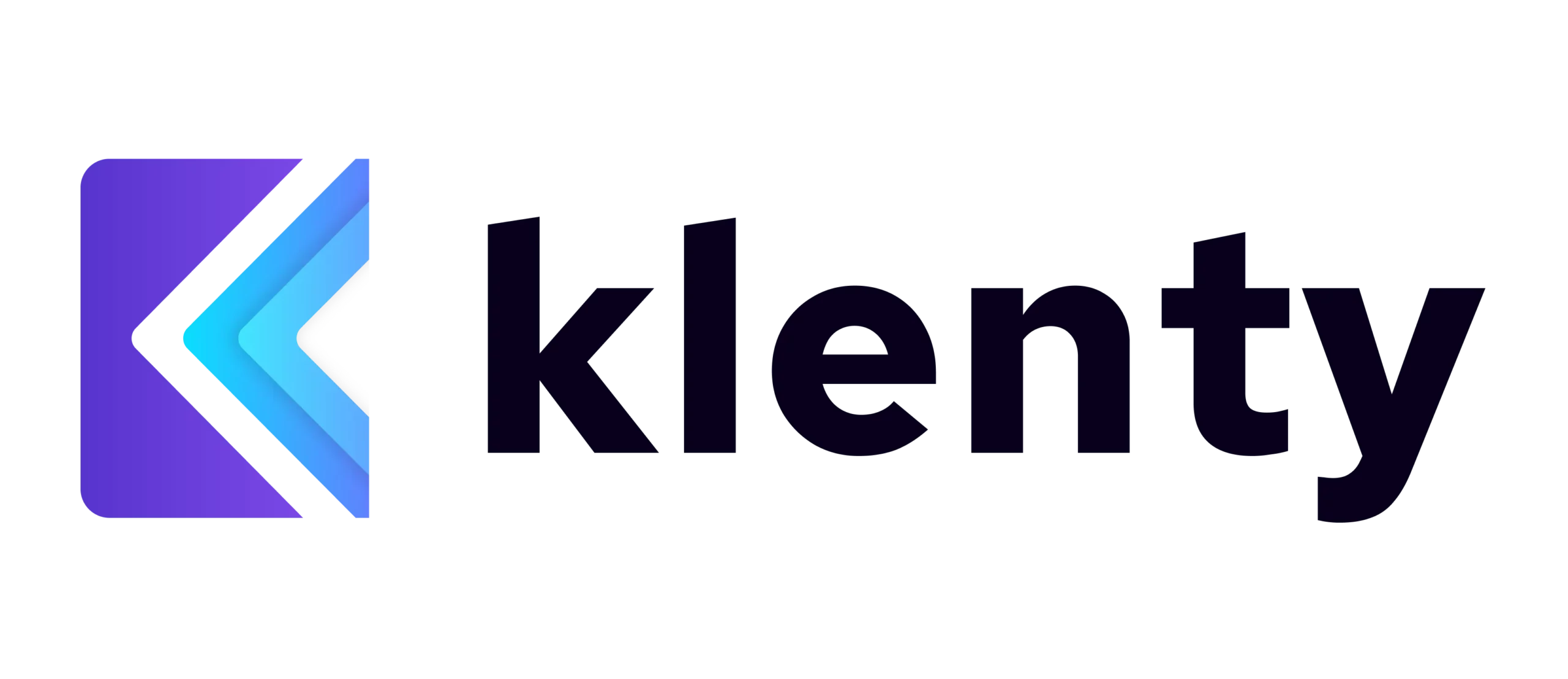Quickmail vs Klenty.
These are two of the most popular sales engagement software out there. Of course, you want the crème de la crème for your sales teams. But how do you begin comparing these tools to make an informed decision?
Fret not, for you are at the right place.
Let’s take a deep dive and assess the capabilities, pros and cons, and user reviews of Quickmail and Klenty to help you form an all-inclusive picture of both of these tools.
What Is Klenty?
Klenty is a sales engagement platform that helps mature sales teams engage prospects strategically across multiple channels, execute the right next step for every prospect, and generate qualified pipeline.
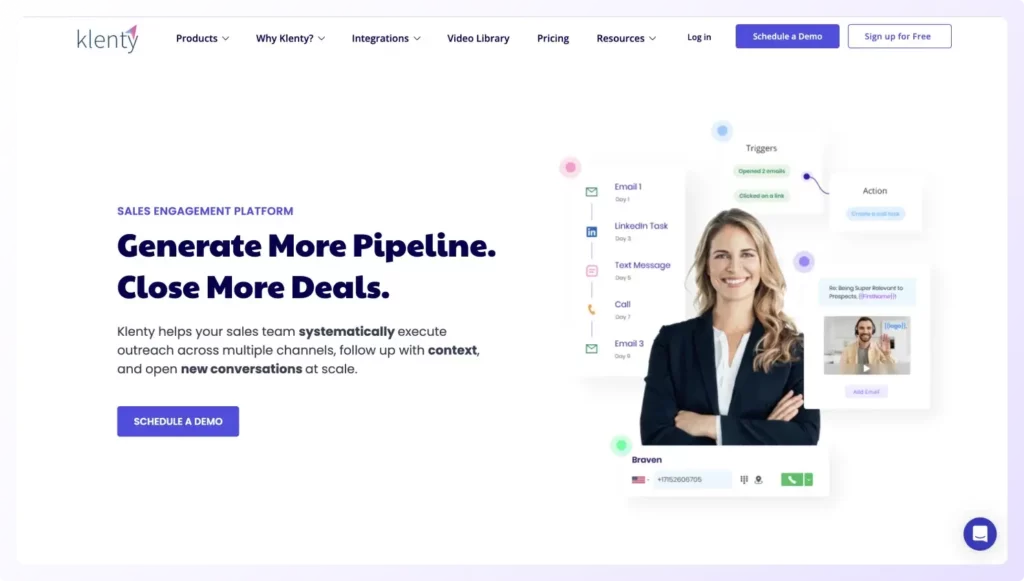
Klenty helps sales teams automate and standardize every single touchpoint—from cold prospect to opportunity to closed-won—to help you build a repeatable sales process.
What Is Klenty Best For?
Klenty is best for sales teams that already have a comprehensive sales process in place. With Klenty, mature sales teams get the standardization they need along with the flexibility to run outreach that is highly tailored to their accounts.
Let’s delve a little deeper into the different ways Klenty can help sales teams meet their goals and become better sellers:
Email-Heavy Sales Teams
For sales teams relying on email outreach and running multiple cold email campaigns, Klenty offers advanced email personalization and ensures high email deliverability to ensure all your emails land on the prospect’s primary inbox and your campaigns see high open and response rates.
Here’s a look at how Klenty helps email-heavy sales teams meet their outreach goals:
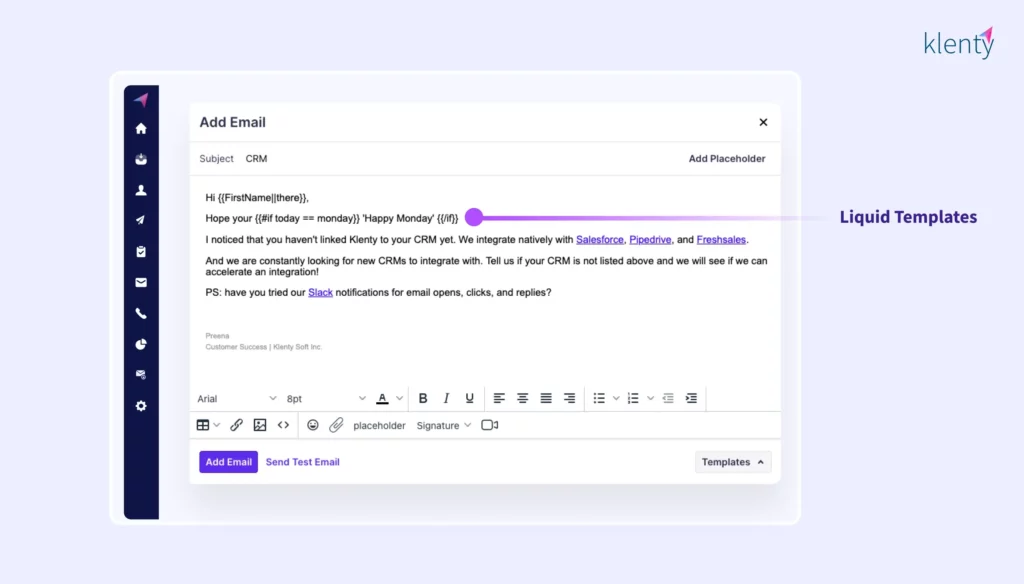
Email personalization:
- Merge Fields lets you add custom phrases, sentences and even paragraphs based on prospect type.
- Liquid Templates uses dynamic formulas to change the content of your emails based on when the prospect receives and opens the email.
- Kai, Klenty’s AI Cadence Writer, scans the prospect’s website and LinkedIn profile and picks out ‘personalization points’ for your emails. It also inserts hyper-personalized openers, ‘problem sentences’ and CTAs to your emails.
Email deliverability:
- Email validation helps reduce bounce rates by automatically validating email addresses for both new and existing prospects.
- Email sending control—Klenty lets you limit the number of emails you send per day and stagger email sending in an irregular manner.
- Deliverability insights give you the percentage of emails that land in the Primary Tab across different email service providers, scores your emails based on spam factors, and gives suggestions for improving deliverability.
Call-Heavy Sales Teams
Klenty’s calling features allow you to dial prospects in bulk and automatically sync all activities, notes, and tasks to your CRM. This makes it ideal for sales teams engaging in high-volume cold calling for their sales outreach.
Here’s a deeper look at the capabilities of Klenty’s Sales Dialer:
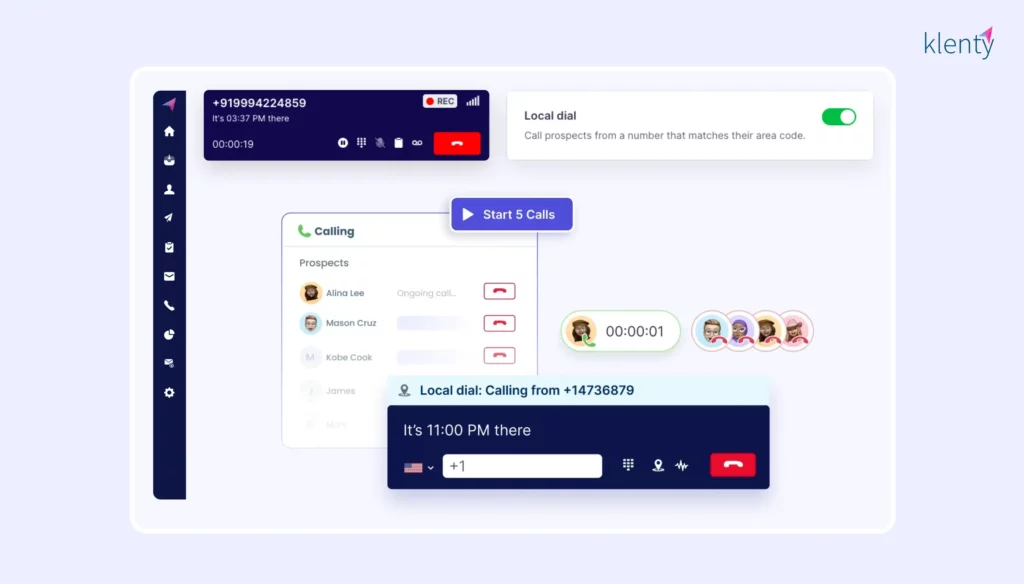
- Parallel dialing. The dialer enables reps to place up to 5 calls simultaneously in one click, enabling you to scale your outbound call volume 5x and boost call productivity by minimizing time spent on unproductive calls.
- AI-powered call notes. Klenty’s conversation intelligence automatically generates highly detailed call notes of your calls. Also, all notes get synced to your CRM instantly.
- Time zone detection lets you batch prospects based on their respective time zones and call them during prime business hours.
- 1-click-to-call dialer helps you dial without any manual effort.
- Voicemail drop lets you send personalized, pre-recorded voicemails with 1 click.
- Local dial to place calls to your prospects using their area code.
- Call reports to measure your performance and find coachable points.
Intent-Driven Outreach
Klenty lets you segment prospects and run the right next steps for them based on their intent. Through this customized outreach and follow-up efforts based on the prospect’s buying journey, you can execute the right activities at the right time for every prospect.
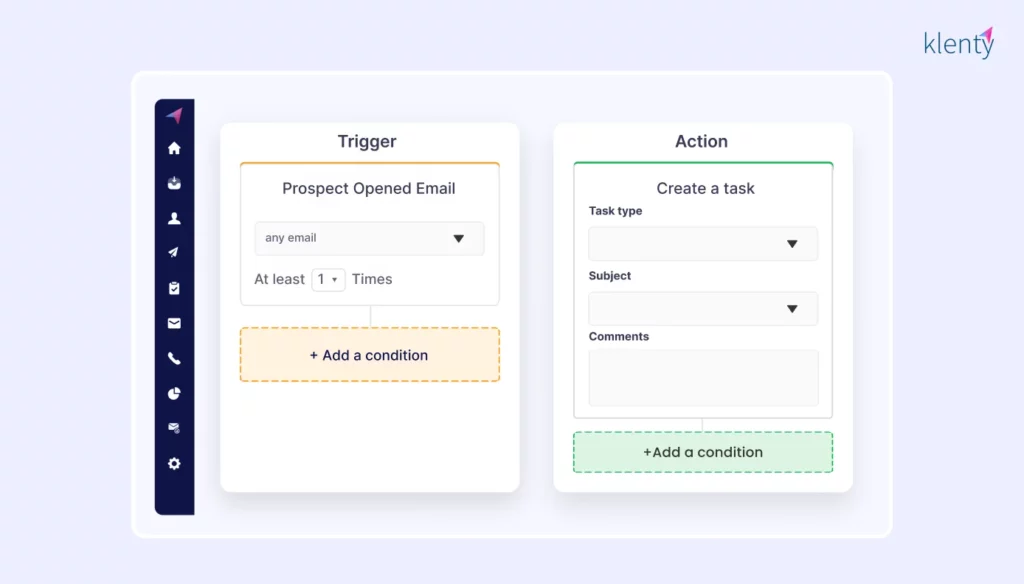
- High Intent Detector allows you to assign points and isolate those prospects who are closer to buying than others.
- Klenty's Cadence Playbooks helps you customize your outreach based on their intent. You can automatically move prospects to a different cadence based on intent, and execute precisely those activities which take each prospect towards a meeting.
Goal-Driven Outreach
With Klenty's Goals and Reports, sales leaders can set up milestones for sales reps to hit on a weekly and monthly basis. This means reps stay accountable to targets and adapt their approach to hit goals.
For every rep in their team, managers can track KPIs like:
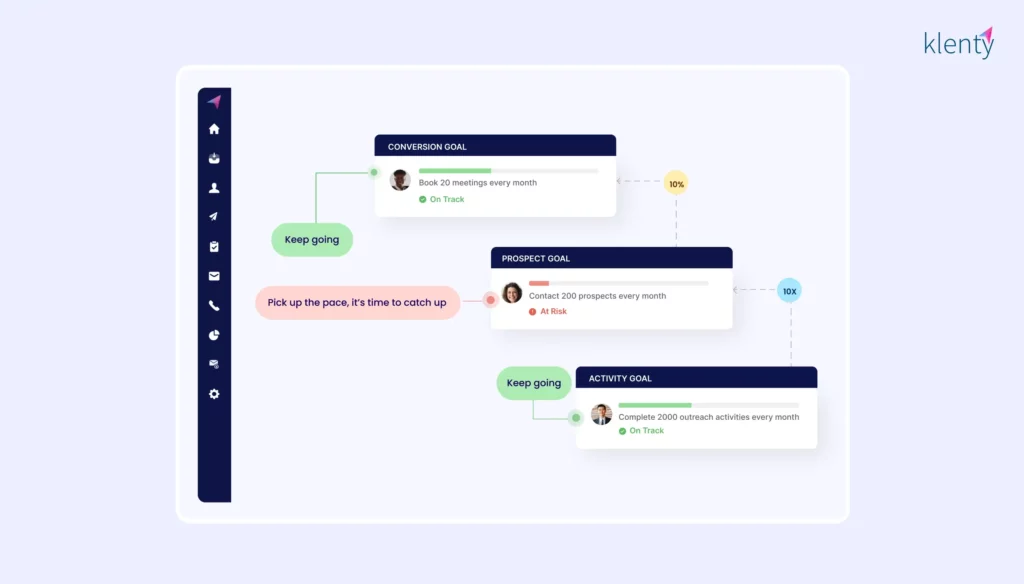
- activity targets,
- prospect coverage targets, and
- conversion targets.
They also get full visibility into rep efforts across emails, calls, LinkedIn tasks, text, and WhatsApp.
What’s more, managers can spot gaps and coach reps to help them to achieve their targets.
Multichannel Outreach
Klenty empowers sales reps to make complete use of 5 different channels:
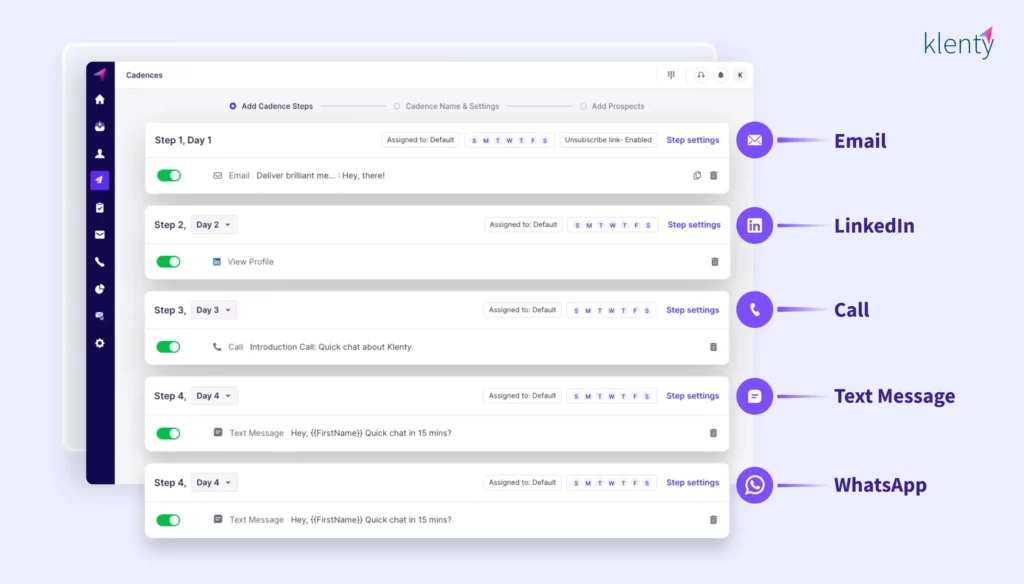
- Phone: Place calls and voicemails in one click without the distraction of dialing.
- Email: Personalize email text and videos with prospect data at scale.
- LinkedIn: Automate LinkedIn-specific tasks like LinkedIn InMails and connect requests in a click with personalization.
- SMS: Use text messaging to complement your cold calls and boost your chances of striking a conversation.
- WhatsApp: Schedule and send personalized WhatsApp messages in one click.
Through a full-fledged and automated multichannel outreach, reps can reach prospects wherever they are, and book more meetings—all at scale.
Plus, Klenty’s multi-channel inbox collates all prospect communication across all channels in one place, so you can manage prospect interactions without the pain of switching tabs.
Pros & Cons of Klenty
Pros of Klenty:
- Easy-to-use interface with no bloatware. Klenty’s intuitive and clutter-free interface makes reps take to the platform almost instantly and see results rapidly.
- Transparent pricing. Klenty’s pricing is available for everyone to see to help you know exactly what you’re paying for.
- 14-day free trial. You’ll get a 14-day free trial to explore all of Klenty’s features with a dedicated account manager, so that you can make a well-informed decision.
- Affordability. With its basic plan starting at just $50 per user per month, Klenty remains a powerful yet affordable sales engagement platform for growing sales teams.
- Pay for what you need. Klenty has tailored pricing plans for email-only sales teams and multi-channel teams. You don't have to pay for features you don't use.
- Powerful dialer for cold calling. Klenty’s powerful Sales Dialer enables parallel dialing, where you can place up to 5 calls simultaneously, all in one click to help you place 5x more calls. The dialer also logs all notes to your CRM, allows you to send voicemails in a click, and batch prospects according to their time zone.
- Intent detection. Klenty’s Cadence Playbooks helps you detect intent in prospects, establish the right next steps for every prospect, and prioritize prospects based on their intent. You gain visibility into where prospects are in their buying journey, move prospects from cadence to cadence based on intent, and execute precisely those activities which take each prospect towards a meeting. No more blind follow-ups.
- Set clear goals for reps. With Klenty’s Goals and Reports, managers can set daily, weekly, and monthly targets for the sales team, get them to commit towards targets for activity, prospect coverage and conversion, and spot gaps as they happen (not after) to ensure timely interventions.
- Advanced email personalization. At Klenty's offers, advanced email personalization doesn’t stop with just placeholders. The ‘Liquid Templates’ feature uses dynamic formulas to change the content of your emails based on when the prospect receives and opens the email.
- Tight integrations that ensure updated CRMs. Klenty smoothly integrates with 5 CRMs—Salesforce, Microsoft Dynamics 365, Hubspot, Zoho and Pipedrive. The advanced integration capabilities include triggers to automatically update contacts from Klenty to CRM and auto-syncing of metrics like opens, clicks and replies along with email conversation history to the CRM. The tight integration ensures an up-to-date CRM and saves hours per day by eliminating manual activities and allows you to focus on selling.
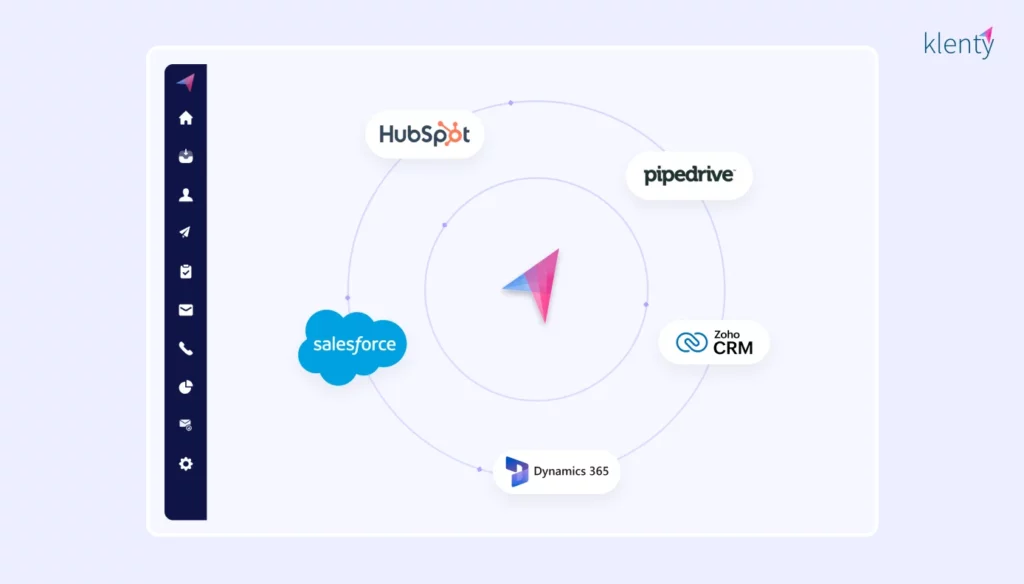
- Helps sales teams consolidate their tech stack. Apart from its sales engagement platform, Klenty also offers platforms to source accurate contact data of ideal buyers (Prospect IQ), schedule meetings automatically with prospects (Schedule IQ), and analyze your calls using AI (Call IQ). With Klenty, you can effortlessly consolidate your tech stack to work with a unified data foundation for all the stages of the sales cycle.
Cons of Klenty:
- User interface. Klenty’s UI can take a few minutes to get used to.
- Pricing. Due to advanced capabilities, the product’s pricing can be a little out of reach for small businesses.
- Not suitable for spray-and-pray. Getting the most out of Klenty requires you to set up a well-planned sales strategy, which can be a bit daunting for teams that use a spray-and-pray approach to outbound.
What Is Quickmail?
Quickmail is an email automation platform that helps reps to automate their follow-ups, scale their email outreach, and boost email deliverability.
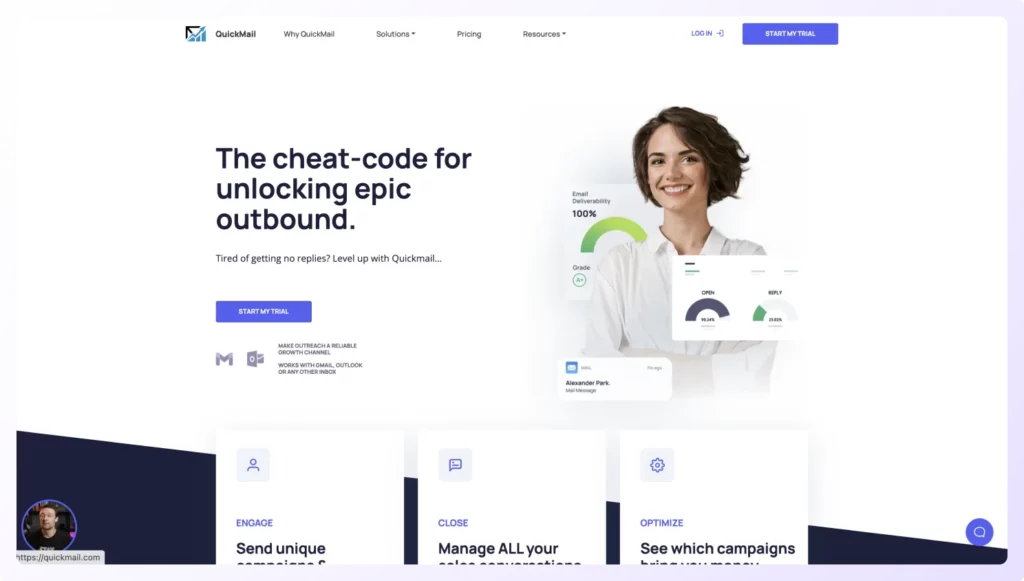
Founded in 2014, the platform also enables sales teams to run multichannel outreach campaigns, as reps can use emails, phone calls and SMS to reach prospects.
What Is Quickmail Best For?
Quickmail is best for sales teams executing email-focused outreach campaigns that involve sending emails in bulk, and are looking to experiment with other channels as well.
Here’s a deeper look:
Email-Heavy Sales Teams
Here’s a look at some of Quickmail’s features that allows execution of effective email campaigns:
- Inbox rotation. With Quickmail, reps can add multiple inboxes per email campaign to spread the load across several inboxes to increase the daily sending limit of a campaign without impacting email deliverability. Email-heavy teams can scale their cold email outreach through this feature. Also, spreading out email outreach to multiple inboxes ensures that emails stay under the radar of spam filters and land on prospect’s inbox.
- Campaign reports. In its campaign reports, Quickmail tracks cold emails that were opened by when they were sent, so that teams can optimize deliverability shifts, optimize scheduling, and improve performance. Plus, the reports also give the reason behind leads unsubscribing from email campaigns (not the right person or timing wasn’t right) to optimize campaigns better.
- Sentiment analysis. Quickmail analyzes the sentiment of your email replies to help reps understand quickly how prospects are reacting to the email campaigns. No more sifting through responses to know if they are good or bad. The platform automatically adds prospects to new follow-up campaigns based on reply sentiment.
- Unlimited split testing. Quickmail enables teams to carry out unlimited split tests for split-testing each part of their email campaigns—whether it’s one or two words or CTAs. With the relevant analytics on these, reps can find out exactly what drives more deals faster and adjust their campaigns accordingly.
- AI-driven automation of admin work. Using AI, Quickmail automates some of the administrative work that reps spend a lot of their time on, such as handling unsubscribe requests, detect and follow up with out-of-office responses and follow-up once they return, and starting a follow-up campaign based on a prospect’s reply.
- Strong deliverability at scale. Perhaps Quickmail’s strongest benefit is its inbuilt email deliverability for all kinds of email outreach, even for bulk email campaigns. The platform comes with free email warmup integration, blacklist monitoring, Google-approved sending API that mimics a human cadence, and real-time deliverability scores for every inbox with every account. Whether it’s 1000 or 100,000 emails, reps can rest assured that each email they send will reach prospects and not hit spam or damage their sender reputation.
- Supports a wide range of email providers. Quickmail supports Gmail, Microsoft Outlook, Amazon SES, PostMark, MailJet, MailGun, Zoho Email and any other email account using Simple Mail Transfer Protocol (SMTP) and Internet Message Access Protocol (IMAP).
Multichannel Outreach
Quickmail enables sales teams to run Multichannel outreach campaigns using 3 channels:
- Email: Run personalized bulk email campaigns with strong deliverability.
- Phone: Integrates with Aircall for call steps.
- SMS: Send text messages to your prospects using Twilio phone numbers.
Pros & Cons of Quickmail
Pros of Quickmail:
- Strong deliverability at scale. Perhaps Quickmail’s strongest benefit is inbuilt email deliverability feature for all kinds of email outreach, even for bulk email campaigns. The platform comes with free email warmup integration, blacklist monitoring, Google-approved sending API that mimics a human cadence, and real-time deliverability scores for every inbox with every account. Whether it’s 1000 or 100,000 emails, reps can rest assured that each email they send will reach prospects and not hit spam or damage their sender reputation.
- Supports a wide range of email providers. Quickmail supports Gmail, Microsoft Outlook, Amazon SES, PostMark, MailJet, MailGun, Zoho Email and any other email account using Simple Mail Transfer Protocol (SMTP) and Internet Message Access Protocol (IMAP).
- Best suited for bulk email outreach. With its inbox rotation feature, Quickmail functions as a platform that’s well-suited for email-heavy teams engaging in bulk cold email outreach. The upper limit for the number of emails that can be sent using this platform is as high as 300,000 emails per month, and the platform comes with robust email deliverability to ensure all emails reach their intended destination: prospect’s primary inbox.
- No upper limit on number of users. With QuickMail, teams can add as many users to their account to handle various aspects of cold email campaigns like setting up emails, updating copy and prospects, managing inboxes, and collecting data. All this at no extra cost.
- Low downtime. Quickmail’s downtime for maintenance only comes to an hour every year. The platform boasts a 99.99% uptime, making it reliable for its users as it isn’t prone to frequent outages and doesn’t impede pre-planned activities.
- Strong automation capabilities. Whether it’s importing prospects, scheduling cold email campaigns, or sending automated follow-ups, Quickmail lets teams automate a large portion of their workflow so that they have time for more meaningful activities. Quickmail also connects with a wide range of sales tools including Zapier, Aircall, Neverbounce, Twilio, and Calendly, making automation more accessible for teams irrespective of the tools they use.
Cons of Quickmail:
- Not suitable for mature sales processes. With its capabilities, Quickmail remains an email automation tool that’s primarily suitable for agencies and demand generation teams, who are looking to scale their cold email outreach process. However, it isn’t a full-fledged and comprehensive sales engagement software suited for sales teams deal with different intent stages and complex buying journeys of prospects.
- Basic multichannel capabilities. Quickmail’s biggest strength is also its biggest drawback—the fact that it’s too email-centric. Its available multichannel capabilities are quite limited for sales reps looking to utilize the full potential of channels apart from email using the same platform.
- Limited CRM integration. Quickmail provides bidirectional integrations with 2 CRMs—Pipedrive and HubSpot—and not with other CRMs popular in the market.
- Lack of goal-driven outreach capabilities. Quickmail can’t allow sales teams to set and track specific outbound goals every day (like contacting X prospects every day) to make every rep in the team accountable to achieve their overall targets.
- No in-built prospect data curation. Within its platform, Quickmail doesn’t enable sales teams to source accurate email and phone data for your ideal customer profiles and target prospects with unique needs based on industry or geography.
- No powerful dialing capabilities. Quickmail doesn’t allow sales reps to dial more than one number at a time, which could be disadvantageous for sales teams that depend heavily on outbound calls.
Have a look at the top 10 Quickmail alternatives here.
Pricing of Klenty and Quickmail
Klenty Pricing:
Here are the pricing details for the different plans that Klenty offers.
- Startup plan: $50/user/month (billed annually) and $60/user/month (billed quarterly). Comes with email deliverability, email personalization, sales ops, reply optimization, and task management features.
- Growth plan: $70/user/month (billed annually) and $85/user/month (billed quarterly). Everything in Startup + multichannel outreach, CRM integrations, intent-based follow-ups (cadence playbooks), and sales management features.
- Pro plan: $100/user/month (billed annually) and $125/user/month (billed quarterly). Everything in Growth + Goals and Reports, 200 credits (Phone+Email), account-based prospecting, and website tracking.
- Enterprise plan: Customized plans available. Everything in Pro + IP-based login restrictions, quarterly customer success review, and advanced deliverability insights.
Quickmail Pricing:
Quickmail has a 3-tiered pricing structure.
- Basic Plan: $49 per month. Comes with 30,000 emails/month, up to 10 multichannel outreach campaigns, free email warmup, reply handling, and blacklists monitoring.
- Pro Plan: $89 per month. Comes with native integration with HubSpot and Pipedrive CRMs, 100,000 emails/month, up to 20 multichannel outreach campaigns, and advanced analytics.
- Expert plan: $129 per month. Comes with 300,000 emails/month and up to 50 multichannel outreach campaigns. In addition to the features in the Pro Plan, this top-tier plan provides Google-approved sending API, AI-driven features and automated follow-up based on response.
All 3 plans support inbox rotation, automatic email warmup, and unlimited team members. Also, the platform offers a 14-day free trial.
What Are Users Saying About Klenty and Quickmail?
A sales engagement platform is a significant investment for your organization, and a wrong decision can prove to be costly.
So, checking reviews on G2 from users who have used the solution you’re evaluating will give you valuable insights about its pros and cons, helping you make a well-informed decision.
That said, let’s see some of the reviews on G2 for Klenty and Quickmail.
Quickmail’s G2 reviews:
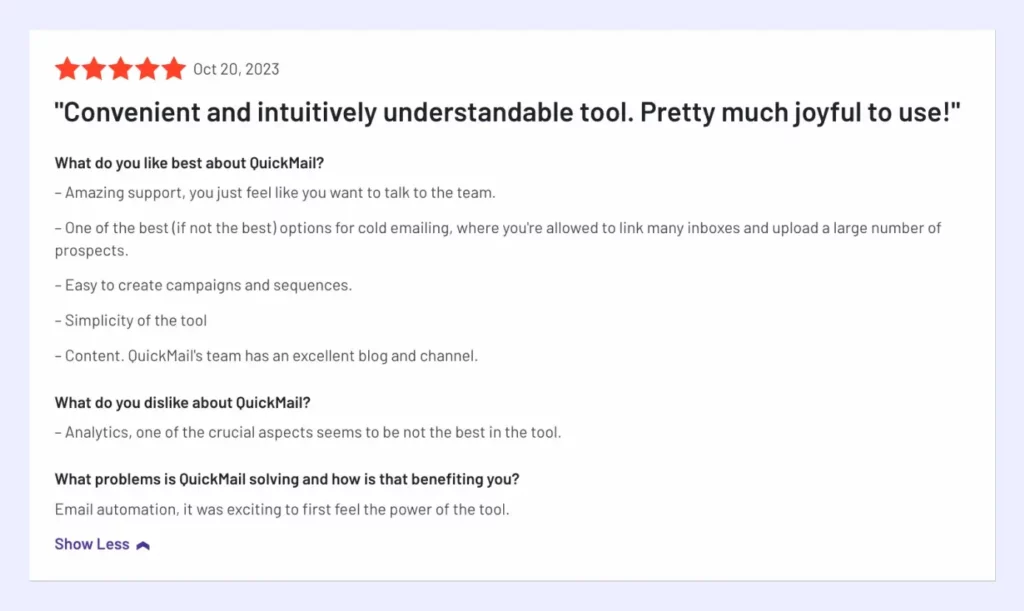
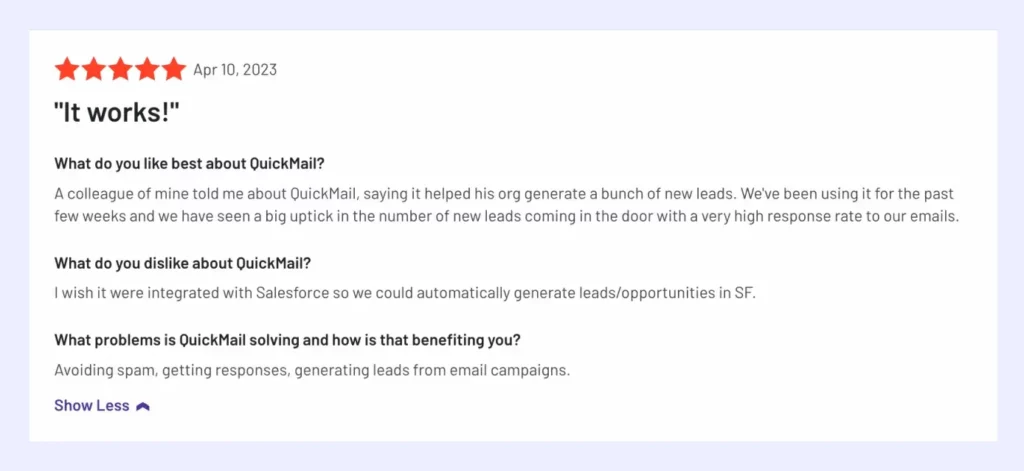
Klenty’s G2 Reviews:
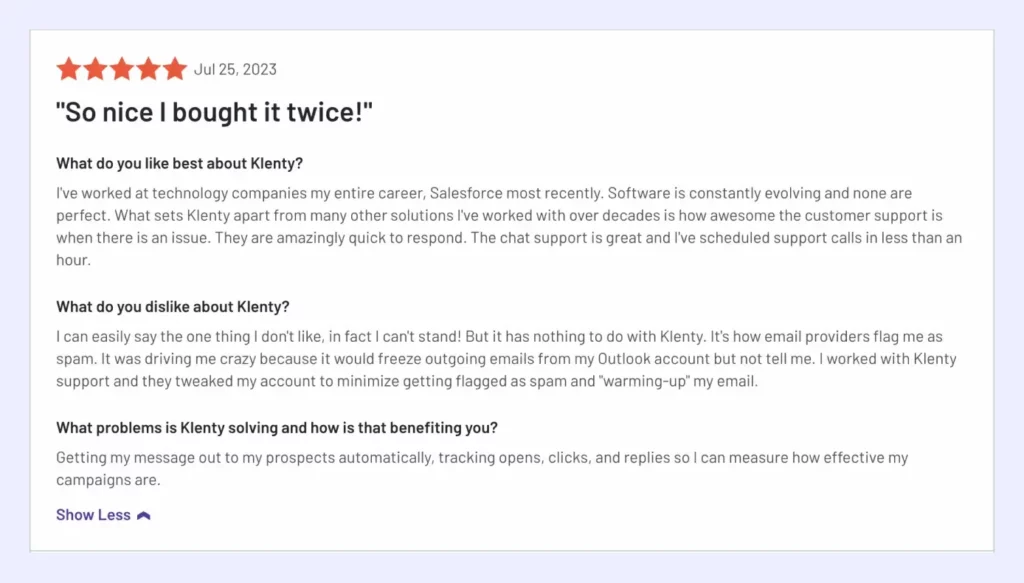
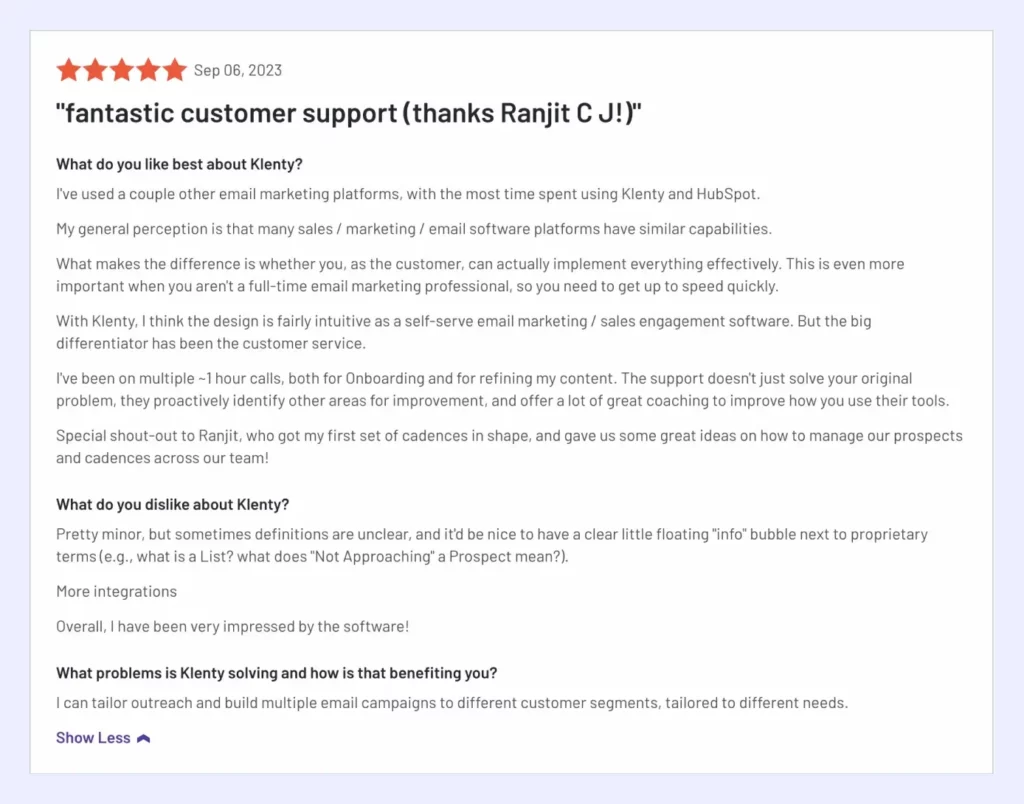
Which Tool Should You Choose?
Quickmail excels at email automation, but falls short when it comes to true multichannel outreach.
Given Quickmail’s capabilities, it is more suited to agencies and demand generation teams that are looking to scale their cold email outreach. The platform can’t cater to the needs of sales teams who follow a mature sales process that’s based on the prospect’s buying journey.
So, sales teams dealing with complex buying journeys and intent stages of prospects will find it easier to rely on platforms that are designed to cater to their varied needs. This is what Klenty was built for.
With Klenty, you can consistently deliver on your pipeline goals by enabling sales reps to plan, execute and track their outreach across 5+ channels and persistently follow up—- all at scale. Klenty empowers you to execute outreach across 5 channels—Phone, Email, LinkedIn InMail, SMS, and WhatsApp—from one place without shuffling between tabs.
Its behavior-triggered playbooks ensures that you send the right message across multiple channels at the right time.
Plus, Klenty also comes with affordable pricing plans, coupled with excellent customer support that’s always free of cost, to ensure the continued success of growing sales teams.
Schedule a demo now to see how Klenty can help you hit your revenue goals!
